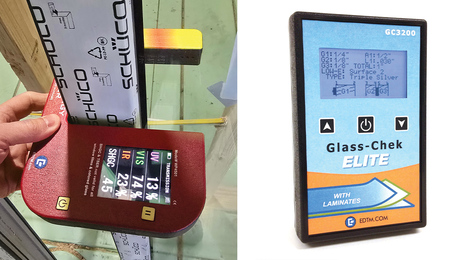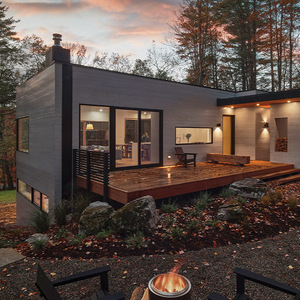As of Jan 1, 2007, all residences (with very narrow exception) will require CO detectors.
http://www.ilga.gov/legislation/publicacts/94/PDF/094-0741.pdf
FWIW, the bill excludes the best CO detectors (most sensitive) because they are more sensitive than the lower sensitivity limits of the UL standards!
Youth and Enthusiasm Are No Match For Age and Treachery




















Replies
Wouldn't the more sensitive detectors still be allowed. I would think that they can be considered to meet the UL guidelines as long as they exceed the minimum sensitivity set by the UL.
Also any total electric home is not required to have one from what I read. idon't think I'd consider that a narrow exception. As long as there are no fossill fuels being in the home then the detectors aren't necessary, no?
Seems reasonable to me.
Tom
Douglasville, GA
Edited 10/8/2006 2:47 pm ET by TomW
For some reason my mozilla and Firefox have stopped handling pdf's, although IE still does. Go figure.The link is the bill itself, so unless you need the gory details ....
Youth and Enthusiasm Are No Match
For Age and Treachery
I got it working and edited my previous response.Tom
Douglasville, GA
>>Wouldn't the more sensitive detectors still be allowed.
I agree, but that's not what the bill says:
To qualify, a CO detector must be one that "complies with the most recent standards of the Underwriters Laboratories or the Canadian Standard Association."
The most sensitive CO detectors are not listed by the UL, the UL's minimum sensitivity allowed is 30 ppm; that level was set following the Chicago "experiment" when they passed a CO detector law in the early 90s(?) - the then available consumer CO detectors were far more sensitive than the testing equipment used by the CHI fire Dept and gas Co.
They responded to a lot of calls and din't find CO in many because of the equipment they were using (and they didn't really know how to test for CO - and they'd have had people open windows to air out the house before they'd arrive to test!) They concluded that the consumer CO detectors were faulty, giving many false positives.
When the UL specs were written, a relatively high minimum was set to avoid too many calls.
The UL itself recommends more sensitive detectors where there are people with higher sensitivity: infants, pregnant women, elderly, people with anemia, immune system problems, heart conditions, etc.
I believe the two best detectors are:
The National Comfort Institute's: http://tinyurl.com/cl4h7 (available only thru certified CO Safety Analysts - (I stock them)
And the one at Aeromedix: http://tinyurl.com/rq29v (available directly from that site)
I don't recommend the combination CO and smoke detectors - the co part of those is the least sensitive type.
I recommend the digital readout type, battery operated, mounted on a wall at about eye level or lightly above: ideally one on each living level, the bedroom(s) are the most important area.
Many suggest in the hall in the bedroom area - but there usually aren't supply registers there - supply registers are 1 way CO can be distributed thru a house.
I suggest (in descending order)
if only one bedroom used, that bedroom
a bedroom above the garage if any
the bedroom of the most vulnerable person in the house
The second CO detector should go in:
Any room with a "ventless" combustion heater or wood stove
the utility room
the next level(s) of the house
The exception is an electric homes _without_ an attached garage:
"(1) A residential unit in a building that: (i) does not rely on combustion of fossil fuel for heat, ventilation, or hot water; (ii) is not connected in any way to a garage; and (iii) is not sufficiently close to any ventilated source of carbon monoxide, as determined by the local building commissioner, to receive carbon monoxide from that source."
I wasn't thinking clearly in calling that "very narrow:" in my area it would be, but might not in other areas, of course.
Youth and Enthusiasm Are No Match
For Age and Treachery
Thanks, interesting reading. Tom
Douglasville, GA
rjwJust curious as to why you prefer battery operated over AC detectors. My older brother has a nasty habit of borrowing or silencing a dying <smoke> detector by removing the 9V battery (and of course never replacing it) so I always recommend going AC.I am not sure if it is required yet by the NEC but I would go so far as to place all smoke/CO dectectors on a seperate AFCI if I were building my own place.Definitely not looking to start an argument on my first post, just interested in your thinking.
Edited 10/9/2006 2:21 pm ET by pill128
>>Just curious as to why you prefer battery operated over AC detectors. My older brother has a nasty habit of borrowing or silencing a dying <smoke> detector by removing the 9V battery (and of course never replacing it) so I always recommend going AC.Good point.I reommmend the battery type because I believe (based on experience and testing) that it is important to have them higher in a roiom than standard plug height.But a plug in would be better in your sort of "environment," I guess <G>There are a couple of models that come with a builkt in extension cord, but that can be somewhat unattractive.
Youth and Enthusiasm Are No Match
For Age and Treachery
I suppose I should have been a little more specific: I believe I have seen round shaped, direct wire CO detectors (not the plug in type). This obviously would require some advaced planning to have a junction box placed in the correct location on a wall but would be a install and forget "appliance" as the NEC would call it.Just a little personal sidenote, I am a recent college grad (2005) in business/computer engineering but I have a passion for building...intellegently. I paid my way through college by swinging a hammer and hope to continue building in some form for the rest of my life. I am planning building my own place next spring/summer and incorporating as many of the good/intellegent/brilliant design ideas that I have picked up over the past 5 years as I can afford, ie the well placed CO detector.With that in mind, I want to thank everyone here in advance for dealing with the two year old in me that has never stopped asking "WHY?"
>>Just curious as to why you prefer battery operated over AC detectors. My older brother has a nasty habit of borrowing or silencing a dying <smoke> detector by removing the 9V battery (and of course never replacing it) so I always recommend going AC.Good point.I reommmend the battery type because I believe (based on experience and testing) that it is important to have them higher in a roiom than standard plug height.But a plug in would be better in your sort of "environment," I guess <G>There are a couple of models that come with a builkt in extension cord, but that can be somewhat unattractive.
Youth and Enthusiasm Are No Match
For Age and Treachery
"...I would go so far as to place all smoke/CO dectectors on a seperate AFCI if I were building my own place."
I've read the suggestion here on BT to have AC-powered smoke detectors wired in the same circuit with a light that's used daily. And I think it's a good idea.
In my house, I have hard-wired interconnected smoke detectors. When one goes off they can all make one heck of a racket.
Since they're on their own circuit, I often just turn the breaker off when they all decide to go off for no apparent reason. (Or when dinner is done)
Then it's easy to forget to turn them back on later. The longest I've gone is about a month, as best as I can remember.
God is dead. - Nietzsche
Nietzsche is dead. - God
That's a great idea. Though its unlikely that the circuit for the detectors would ever trip, without some other known device on the same circuit, if it did trip you wouldn't know that you were unprotected until the next trip to the breaker box.Thanks BossHog
If you are getting AC powered detectors be sure to have a battery backup on them. I sure there are a good number of fires stated each year by burning candles during a power outage.
Personally I like low voltage hardwired detectors tied into an alarm system. Tom
Douglasville, GA
"If you are getting AC powered detectors be sure to have a battery backup on them. I sure there are a good number of fires stated each year by burning candles during a power outage.
Personally I like low voltage hardwired detectors tied into an alarm system. "
I was about to say the same thing. The security system provides the battery backup, plus it will call out in the event of a fire (the smoke detectors in my house are set up with a short time delay, so I can prevent the system from calling out if all I did was burn dinner.)
No thanks needed. That's just one of the hundreds of things I've picked up from hanging around here on BT. so it wasn't my idea - I just passed it along.
If voting could really change things, it would be illegal.
Bob,
Which are the best CO detectors? What about the combo smoke/CO detectors?
Thanks,
Tim
Thanks for the info. This was news to me.
Bob,
Do you have access to any stats on CO deaths in the US / year?
Per David G. Penney, Ph.D.'s "CO Headquarters:"
QUOTE
Annually in the USA:
Tens of thousands of people seek medical attention or lose several days, weeks, months of normal activity from CO exposure/li>
Over 40,000 emergency department visits for CO poisoning (estimated; Hampson, 1999)
More than 450 people die through unintentional CO exposure (CDC)
As many a 2000 people die intentionally using CO (CDC)
ENDQUOTE
http://www.coheadquarters.com/CO1.htm
See, also, the chart (& numbers) at: http://www.coheadquarters.com/coPC96-97cause1.htm
Dr Penney is a (the?) leading authority on the health side of CO.
Youth and Enthusiasm Are No Match
For Age and Treachery
I'm not too fond of CO detector requirements. "If it saves a life..." is simple cant.
The use, or application, of the things is still open to debate. The NFPA standard takes 22 pages to say "follow manufacturer's instructions." The instructions use a lot of ink to say, 'put them wherever you feel like.'
Something that is "good" is not always something that ought to be 'required.' CO detectors have a few drawbacks:
- They have a short life, perhaps 5 years, and must be replaced (they stop working);
- They are quite temperature sensitive, and WILL alarm in freezing conditions. Considering that many sources of CO are in the garage, this is an issue;
-Many combined CO / Fire detectors are marketed. Yet, there is no reason to suppose that a good fire detector location is also a good CO detector location;
- Different alarm types sound alike. You have no way to identify the problem quickly; and,
- The response to a CO alarm is different from the response to a Fire alarm. Were my CO detector to sound off, calling the fire department is WAY down on my list of responses.
Notice I said "MY CO detector. I have one. I have placed it as I see fit. I see no reason to suppose that I am any smarter, or wiser, than others; if I can figure this out, so can they.
I agree somewhat about the possible problems with regulations requiring them.I have worked with a few cities looking at enacting such ordinances.And I have learned that some aspects of CO safety are non- or counter-intuitive.FWIW, my views are based on several classes in the subject of CO safety Analysis and Combustion Analysis and a lot of field testing and emergency response.I find that of the few people who have CO detectors, most have the least sensitive type and have them in the wrong place: mounted low on a wall, either in the living area or the utility room.+As stated, my opinion is that bedrooms are the most important area to protect and the detector should be about eyelevel or slightly above.I have never run a cross a situation where CO concentrations are higher near the floor.Usually, by the time I get there, they are pretty evenly distributed, top to bottom, but high concentrations are (almost?) always first found high in a room.I have seen levels well above 100ppm at ceiling level with a plug in co detector 18" +/- above the floor completely "oblivious" to the CO.+ Where the heat distribution is NOT forced air, the utility room makes sense.Because one possible source of CO in the house's air is from a cracked heat exchanger, a utility room location is the last place to find high CO. In one emergency response I did several years ago, the stove was the source. The kitchen had very high levels, the CO was picked up from the kitchen through the returns and distributed through the house (at lower levels, of course, because there were multiple returns) and the basement utility area "combustion zone" had the lowest level - I believe because of the infiltration of combustion air from outside.
Youth and Enthusiasm Are No Match
For Age and Treachery
What if the house is all electric? A couple of search hits I looked at (CDC for one) only point to combustable heat as sources of CO. Am I missing some? I guees maybe a fireplace but it'd have to have a pretty poor draft and be burning for a while & not all houses have fireplaces.
>>What if the house is all electric? That is the exception, so long as it doesn't have an attached garage. (Cars produce large amounts of CO and csome CO responders report they are the most likely cause of an alarm sounding.)Note that an electric stoive can produce CO in self-cleaning mode.I don't think that would necessitate getting a detector, though, keep windows open and exterior exhaust fans going and don't hang out in the kitchen out to do it.
Youth and Enthusiasm Are No Match
For Age and Treachery